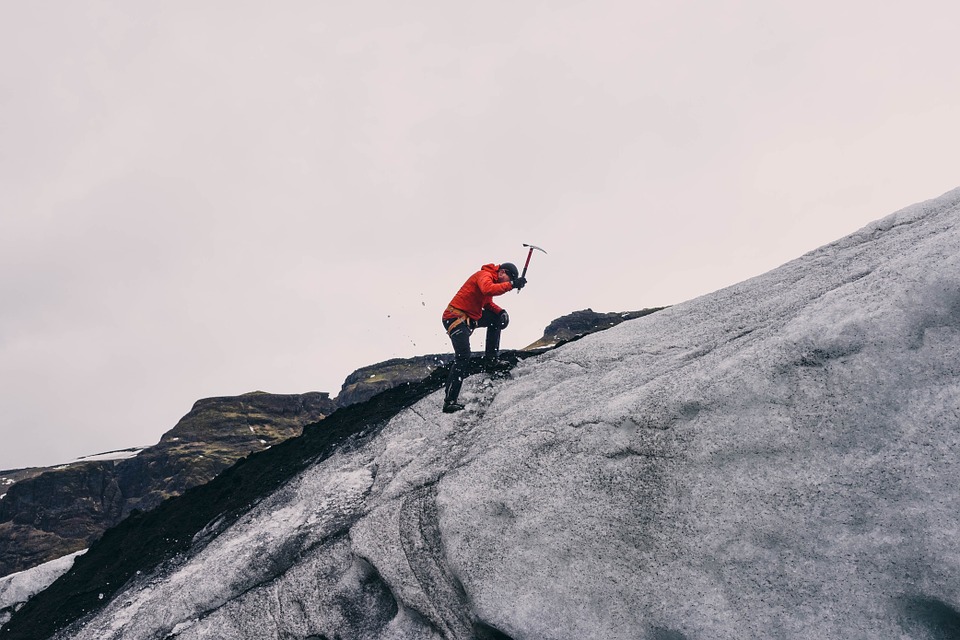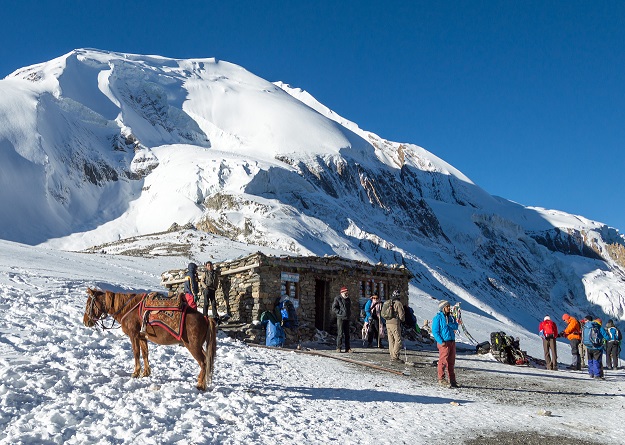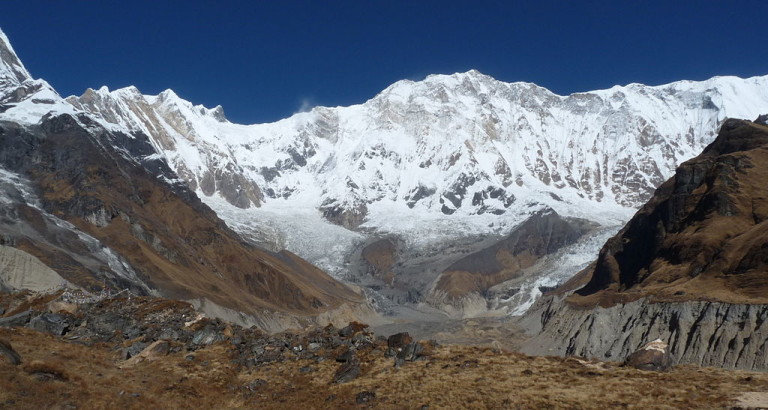- HOME
- Destination
- Adventure Activities
- About Us
- BLOGS
- CONTACT US

Have you ever heard about the casualties and deaths while proceeding towards the higher altitudes? Every year we hear many people losing their life due to their inability to cope with the environment at higher altitude. The characteristics of high altitude like cold, low humidity, increased harmful sun rays, decreased air pressure are all problems for the trekkers.
The biggest concern may be the decreased amount of oxygen in the air of higher atmosphere. You might also have experienced some uneasiness during hiking or travel to a higher altitude place. We call it “Altitude Sickness.” Have you ever been concerned why does it happen and how does it affects our system? Here is what is it and how can you prevent yourself from it.
Many people on a daily basis move upward to a higher altitude for work, trekking or athlete. In higher altitude, the pressure exerted by the air (barometric pressure) decreases leading to the decreased amount of oxygen in the atmosphere. People living in the lower altitude have adopted the environmental conditions accordingly.
The human body has a capacity to adjust properly to moderate change in atmospheric pressure but of course, it takes time to do so. If they head towards higher altitude rapidly, their body could not get enough time to adapt to the atmosphere and thus resulting in some uncomfortable situations. This phenomenon is called Altitude Sickness. Symptoms may include a minor headache, dizziness, and vomiting to behavioral changes and unable to walk properly.
Altitude sickness generally occurs above 2,500 meters (8,000 ft). However, some can be affected in lower altitudes too. The men are more prone to altitude sickness than women, and the reason behind is yet to be disclosed. The possibility of suffering from altitude sickness is independent of your age and fitness.
It means being young and fit does not primarily mean that you are immune to the sickness. Also, it is important to keep in mind that just because you have not experienced altitude sickness in your previous trips to the higher altitude, does not make you are resistant to the possibility of occurrence of sickness in the future.
Although it cannot be determined whether an individual is at the risk of altitude sickness, certain people can be at a higher risk of altitude sickness:
– Someone who has not been in altitude over a period of two weeks or more.
– Someone who has previously suffered from higher altitude illness.
– Who drinks alcohol before adjusting to the changing climate.
– Ascend rapidly (more than 500 to 1000 meters per day) above 2700 meters (9,000 feet).
– People with heart and lungs disease may be more vulnerable to altitude sickness.
– Pregnant women should consult their doctor before traveling to higher altitudes if there can be any risk.
The major cause of altitude sickness is moving upward rapidly towards higher elevation. Climbing higher too rapidly and living there for a considerable period may cause altitude sickness.

Altitude Sickness
In the lower atmosphere, the percentage of oxygen in the atmosphere is about 21%, and the atmospheric pressure is about 760.00 mmHg. The increase in altitude reduces the number of oxygen molecules per breath. It is almost reduced to half when we reach an altitude of 5,500 meters (18,000 feet). To adjust in such a condition, one should breathe in and out in a faster rate, and the heart should beat faster too. The blood oxygen levels increase as we breathe at a faster rate. However, it doesn’t meet as much as it was in sea level.
Since the body is not adapted to the lack of oxygen and decreased atmospheric pressure; it needs some time to prepare itself for the existing environment. This can be achieved by climbing forward at a slower pace. The slower ascend is called acclimatization.
The human body in average needs 1 to 3 days to be acclimatized in a certain environmental condition. Anyone who does not spend enough time to prepare themselves for the changes occurring in the atmospheric condition has a higher chance to suffer altitude sickness.
In higher altitude the blood experience the lack of enough oxygen and thus making the heart and lungs to work harder. The body requires more blood cells to carry the oxygen throughout the body. The body reacts to the change in the body by altering the lung pressure, blood acidity level, electrolyte level, and fluid and salt balance. This leads to uncomforting situations which we suffer.
Acute Mountain Sickness or Acute Altitude Sickness is the most common form of altitude sickness. It generally occurs above 2,500 meters although some are affected even at lower altitude. AMS occurs in 20% of the people after rapid ascend to 2,500 meters (8,000 feet) and 40% of people going to 3,000 meters (10,000 feet). Generally, you start to develop the symptoms as you climb up to 6 to 10 hours a day. The Acute Mountain Sickness is the least dangerous among the types of the altitude sickness.
The symptoms resolve after acclimatization in 1 or 2 days within the altitude of 3000 meters and may take a longer time if it is higher.
But, if the symptoms do not resolve, then the only option is to descend downward i.e. at least 500 meters.
The Acute Mountain Sickness shows the following symptoms:
– A headache
– Feeling tired and weak
– Nausea and vomiting
– Feeling dizzy and lightheaded
– Trouble in sleeping
– Loss of appetite
High-altitude Pulmonary Edema is the reaction of lungs towards the increasing altitude. It is still not sure who suffer from HAPE. HAPE may or may not be associated with other symptoms of the altitude sickness. Generally, climbers reaching altitudes of over than 14,000 feet suffer from HAPE. A low concentration of oxygen at higher altitude causes the lungs to contract.
The contraction creates a higher pressure in the arteries which leads to the leakage of the fluid from the artery into the lungs. This is called High-altitude Pulmonary Edema (HAPE). This condition is one of the greatest threat to the life of the trekkers and climbers in higher altitudes.
The symptoms of High-altitude Pulmonary Edema (HACE) include:
– Chest tightness or fullness
– Inability to catch breathe, even while resting
– Extreme fatigue
– Lips and fingernails turn blue or grey
– A cough, which may produce frothy pink fluid
– Fever
– Noises when breathing, such as rattling
High Altitude Cerebral Edema (HACE) is the extreme form of Acute Mountain Sickness (AMS). During HACE, fluid leak out of the blood vessels in the brain. About 1% of the people who ascend to above 3100 meters get HACE. However, the lowest altitude where HACE has been reported is 2100 meters.
The primary cause of the occurring of HACE is ignoring the symptoms of AMS and continuing the journey towards higher altitude rather than staying in the same altitude or descending.
The symptoms of High Altitude Cerebral Edema (HACE) comprise of:
– Worsening headache and vomiting
– Walking with a staggering gait
– Confusion
– Exhaustion
– Visual hallucinations (seeing things that are not real)
– Change in the ability to think
– Change in normal behaviors
– Loss of consciousness
These symptoms show an adverse effect on various systems in our body. Some systems affected by the altitude sickness with their respective symptoms are:
– Gastrointestinal System: Loss of appetite, nausea, and vomiting
– Nervous System: Weakness, headache, and dizziness, lack of sleep
– Locomotory System: Swelling of hands, feet, and face
– Respiratory System: Shortening of breath, nose bleeding
– Cardiovascular System: Increased heartbeat
It is very important to know if you are suffering from altitude sickness. You must be able to observe the symptoms carefully in order to know the effects of the higher altitudes and prevent further seriousness. Otherwise, the altitude sickness might turn fatal.
If a headache is your only symptom, you can deal with it with a pain reliever. However, if the pain does not go away and you find the condition worsening, there may be other symptoms associated with Acute Mountain Sickness (AMS). This can be diagnosed without any special tests.
The heartbeat rate and the breathing rate of the patient suffering from altitude sickness are faster than normal.
High-altitude Cerebral Edema (HACE), as mentioned in the symptoms makes an individual difficult to walk in a straight path. If any kind of changes in a person’s personality or thinking is observed, then he is suffering from HACE. Once a person suffers from HACE, he must be given immediate medical support. A Magnetic Resonance Imaging (MRI) will be a good idea to know if the brain is swelling.
Normally, it is difficult to recognize the High-altitude Pulmonary Edema (HAPE) because the only symptom may be fatigue. Apart from the above-mentioned symptoms, the HAPE can be diagnosed by listening to the lungs with the stethoscope. The crackling noise in the stethoscope reveals the suffering from HAPE.
The doctors treat the patient fever and cough for pneumonia to diagnose high-altitude pulmonary edema (HAPE). The alternation in mental state or coordination in a person indicates High-altitude cerebral edema (HACE).

Tourists and horse at Thorong La pass tea house
You can adopt the following first aid tips if you or anyone in your group suffers from the altitude sickness:
– Don’t hurry in climbing. Camp and wait until the symptoms resolve. It may take a couple of days. Waiting for the symptoms to disappear helps your body to acclimatize in the atmospheric condition.
– The casualties should avoid alcohol and cigarettes.
– Breathing deeply helps to reduce the concentration of carbon dioxide in the blood. So, the victim must be encouraged to take breathe deeply.
– Provide oxygen from the portable oxygen cylinder
– If the case is serious, descend immediately up to 500 to 1,000 meters.
If you wonder if altitude sickness could be prevented or not, then “YES” is the answer. You can prevent altitude sickness. The body needs some time to adjust to the changing atmospheric conditions and the alternation in body’s function can be prevented by some of the following ways:
– Avoid flying directly to higher altitude
– Drink plenty of water: Climbing to the higher altitude, our body loses water quickly and thus plenty of water intakes is necessary to prevent dehydration. As a general rule, you need to drink twice as much water at higher altitudes than you take at your home.
– Take care of your diet: Foods rich in carbohydrates will help you adjust to higher altitudes. Complex carbohydrates like white bread, white rice, sweet potatoes and beans maintain energy level of the body improve the body’s ability to absorb oxygen. Similarly, the food rich in Potassium is also recommended since they help balance the salt intake. In addition to this, you can help yourself by taking Iron containing foods like red meat, peas and green leaves.
– Say no to alcohol: Alcoholic beverages are diuretic and enhance the loss o water from our body through urine. In order to prevent the loss, any kind of alcoholic beverages must be avoided.
– Do not smoke
– Ascend slowly: Our body requires some time to adjust to different environmental conditions. So, if you are traveling to higher elevations from sea level, then you must proceed gradually. Take 2 to 3 days rest the same place when you reach above 3,000 meters. Also, remember that you do not take any heavy exercises for the first couple of days at higher altitude.
– Follow “Climb high sleep low” rule: Do not increase your sleeping altitude abruptly. Your sleeping altitude should not be increased more than 300 meters a day. Even if you climb to higher altitudes, then return to a lower sleeping elevation at night. For example, you can book your hotel a couple of thousand feet lower than the mountain you will be climbing or hiking. This helps you to better acclimatization.
– Do not use sleeping pills to treat insomnia. These pills can suppress breathing.
Altitude sickness can be treated in the following ways:
The most appropriate idea to deal with the altitude sickness is to descend to the lower elevations. If the symptoms are mild, you can take rest in the same altitude without descending and wait for the symptoms to be gone. But if the symptoms are severe, then my friend, you have no choice at all. You must move down as soon as possible whether it can be in the early morning, in the midday or the midnight. You must descend about 1,500 to 2,000 feet in severe condition. And please don’t underestimate the symptoms because, in severe conditions, these symptoms could be fatal.
Carrying a portable oxygen chamber is a good idea. Some highly skilled climbers carry these chambers called a hyperbaric oxygen chamber. Providing oxygen helps a person with a severe breathe problem. A respirator and a long inhaler can also be a good idea.
It is a unique and a portable bag used for the treatment of Altitude sickness. The bag increases the air pressure around the patient and thus can be used if immediate descend is not possible. The bag can reduce the altitude by 1,500 meters and thus minimize the serious symptoms at higher altitudes.
Besides descending to the lower elevations, altitude sickness could be treated by some drugs and medications. Some of the altitude sickness pills include:
Acetazolamide or Diamox is a medical agent for treating Acute Mountain Sickness (AMS), High Altitude Pulmonary Edema (HAPE) and High Altitude Cerebral Edema (HACE). It encourages the chemical balance in the blood and speeds up the breathing rate. It discourages the Carbonate anhydrase enzyme and facilitates the excretion of bicarbonate in the urine and thus speeds up the acclimatization.
The trekkers and climbers are recommended to have 125 mg, twice a day, orally 24 hours before starting to ascend to a higher altitude. The drug, however, shows some side effects such as itching of fingers and toes and frequent urination which might affect the daily activities and night sleep.
Dexamethasone is usually used to treat cerebral edema. It also reduces the symptoms of Acute Mountain Sickness by 63%. Dexamethasone has no effect on fluid shifts, oxygenation and interrupted breathing during the sleep. The drug is successful in reducing the acute mountain sickness in an effective manner but, does not improve the physiological abnormalities. Dexamethasone is therefore recommended only when descent is impossible. The patients usually experience improvement in about 6 hours. This medicine may result in some side effects like stomach pain and headache.
Nifedipine prevents and treats High Altitude Pulmonary Edema (HAPE). This drug prevents the narrowing of the pulmonary artery which reduces chest tightening and ultimately making breathing easier. Since, the preventing of the narrowing of the artery may reduce blood pressure suddenly, do not get up suddenly after taking the drug.
The recovery time depends on how severely an individual is affected by the symptoms and how fast he/she can be moved to lower elevations. In lower altitudes, the symptoms can be recovered in just a few days while it may take a longer time in higher altitudes. The consequences may be life-threatening if the person remains in the same altitude despite of severe symptoms. Acute Mountain Sickness can be resolved more quickly without problems but the high-altitude pulmonary edema and high altitude cerebral edema may have a longer recovery time lasting up to weeks to disappear and may need medical attention.

View from Annapurna Base Camp
Normally a person does not understand if he is suffering from altitude sickness. The confusion leads to the negligence of the symptoms which may grow serious as proceeding to higher elevations. Thus, it causes a serious threat to our lungs and brain which may turn fatal.
In case you are experiencing minor symptoms like a simple headache or shortening of breath, you can visit a doctor rather than descending downwards. If the symptoms are serious and do not offset on resting, it’s time to descend in speed and find a medical person as soon as possible.
If a person is seriously attacked by altitude sickness, then he must be descended and seen by an emergency medicine physician. A hyperbaric-trained physician might also be involved in the care of the patient. You can also consult a neurologist or pulmonary or critical care specialist.
Is follow up with the medical personnel necessary after the treatment of Altitude Sickness?
Most people who suffer minor symptoms and self-curing mountain sickness do not need to follow up with the doctors. However, for those who experienced serious High Altitude Pulmonary Edema and High-altitude Cerebral Edema need more frequent follow up with their doctors.
The death zone is the altitude above which the amount of oxygen is relatively lower to sustain human life. Generally, altitudes above 8,000 meters (26,000 ft) are considered as death zones. The human body cannot acclimatize in death zone and a stay of higher duration in these zones leads to serious effects like the deterioration of body functions, loss of consciousness and ultimately death.
Your email address will not be published.Required fields are marked *
You must be logged in to post a comment.
0 Comments on "Altitude Sickness – Symptoms, Causes & Preventions"